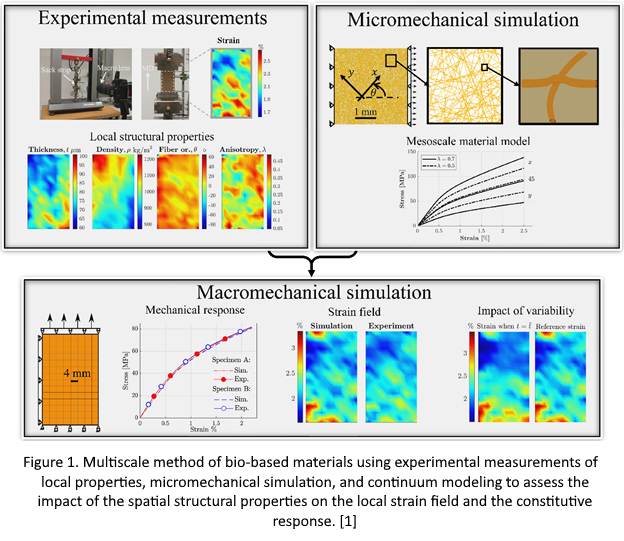28.10.2021
Bio-based Materials (BM) present a promising potential to be used in many engineering applications. However, the variation in their mechanical response, consequently the sudden failure, is one of the main drawbacks for expanding their usage. Typically to avoid the stochastic failure of these materials, a higher safety factor is used during the product design. This solution implies using a greater amount of the material leading to unfavorable ecological and economic impacts.
The difficulties associated with accurately predicting the response of the BM boil down to their stochastic nature. The fiber network, as the base structure of biobased materials, is of a complex structure with inhomogeneity and random spatial structural properties. Relying solely on the experimental studies does not always lead to a deeper understanding of the parameters that control the strength of the material, hence the modeling approach is of utmost need.
Many models are presented to replicate the mechanical behavior of BM. In general, they can be sorted out into two main modeling groups: namely, the micromechanical approach, and the continuum approach. The micromechanical modeling approach is detailed as it takes into account the response of the single fiber, geometrical properties of the fibers, and the interactions between them. Yet this approach cannot be used to model the product size due to the formidable computational cost. This tool is used for small sizes typically of mm, for instance, 6×6 mm2.

In contrast to the micromechanical modeling, the continuum approach uses simplified assumptions with neglecting the micro properties and local structural fields such as thickness, density … etc. This simplicity results in a supreme efficiency of the computational performance and an easier calibration of the model. Nevertheless, as everything comes with a price, this simplification leads to inadequately predicting the material response and in many cases, the material fails at a lower load than that predicted from the continuum model.
To combine the advantages of the computational efficiency from the continuum modeling and the detailed modeling from the micromechanical tool, a multiscale approach, see figure 1 alongside, is introduced. This approach aims at bridging the gap between different scales to provide a comprehensive understanding of the factors that control the mechanical response of such complex materials. This deeper knowledge will lead to minimizing the loop time of designing and testing the new products, consequently lowering the cost. Also, it will help to enhance the end-user experience through enabling new material design which is currently unattainable.
[1] Alzweighi, M., Mansour, R., Lahti, J., Hirn, U., Kulachenko, A., 2021. The influence of structural variations on the constitutive response and strain variations in thin fibrous materials. Acta Mater. 203, 116460. https://doi.org/10.1016/j.actamat.2020.11.003
Writer:
Mossab Alzweighi
ESR8 - KTH
